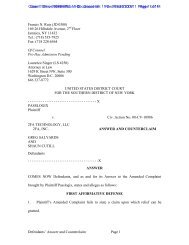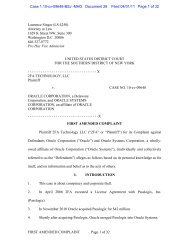Syncsort v. Innovative Routines.pdf - Trade Secrets Institute
Syncsort v. Innovative Routines.pdf - Trade Secrets Institute
Syncsort v. Innovative Routines.pdf - Trade Secrets Institute
- No tags were found...
You also want an ePaper? Increase the reach of your titles
YUMPU automatically turns print PDFs into web optimized ePapers that Google loves.
There are a number of cases involving widespread distribution of materials to acontrolled audience, in which courts concluded that the trade secret remained intact. In DataGeneral Corp. v. Digital Computer Controls, Inc., 357 A.2d 105 (Del. Ch. 1975), Data Generaldistributed design drawings to customers for use in maintaining its minicomputer system.Although the drawings contained sufficient information to enable a competitor to design acompeting system, the information remained a trade secret because the documents noted thatthey were not to be used for manufacturing purposes and not disclosed without permission. Seegenerally Data General Corp., 357 A.2d 105. The defendant estimated that as many as 6,000people outside the plaintiff’s company had access to the secret information, nevertheless, thecourt concluded that the “dissemination is not significant if in confidence.” Id. at 108 n.5(citations omitted). Since customers were required to sign a non-disclosure agreement, whichstated “drawings are not to be used for manufacture or sale of the items disclosed without writtenpermission,” and included confidentiality legends on the manuals themselves, id. at 110, theplaintiff’s measures were adequate to maintain its trade secrets. Accord Unix Sys. Labs. v.Berkeley Software Design, Civ. No. 92-1667 1993 U.S. Dist. LEXIS 19505, at *47 (D.N.J. Mar.3, 1993) (Debevoise, J.) (“Plaintiff argues that these programs contain a variety of materials thatDefendants could have obtained only from proprietary sources, sources subject to contractualguarantees against redistribution. If so, then Plaintiff has not lost its secrets. <strong>Trade</strong> secrets neednot actually be secret, as long as the owner of the secrets controls their dissemination. Forexample, the owner may disclose it to employees or to others pledged to secrecy.”); cf. Board of<strong>Trade</strong> v. Christie Grain & Stock Co., 198 U.S. 236, 250-51 (1905) (Holmes, J.) (Plaintiff’s“collection of quotations . . . stands like a trade secret. . . . The plaintiff does not lose its rights bycommunicating the result to persons, even if many, in confidential relations to itself, under a28








